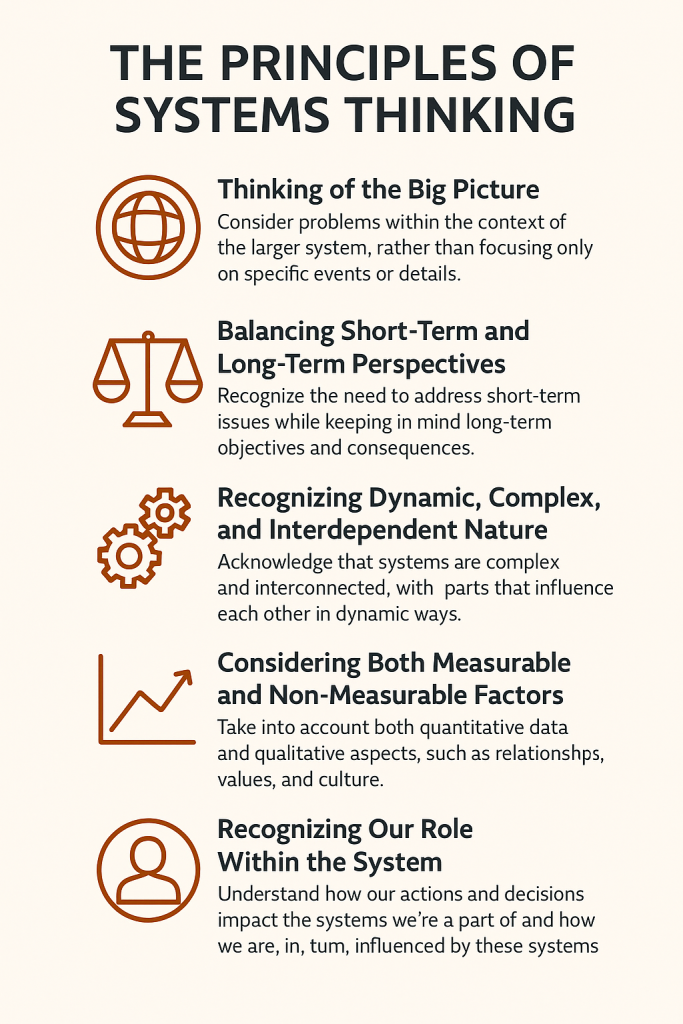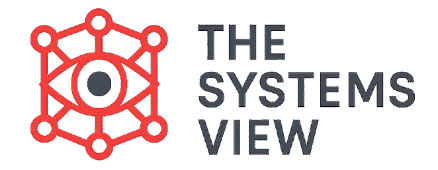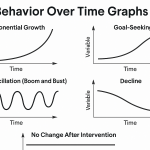Systems Thinking is more than just a set of tools; it is a way of seeing the world. Instead of focusing only on isolated events, it helps you see the connections, patterns, and hidden structures that cause problems to happen. This powerful way of thinking was developed by brilliant minds in different fields, such as Russell Ackoff and Peter Senge. It helps you move from just reacting to problems to truly understanding them and finding lasting solutions.
By learning the principles of Systems Thinking, you can spot the hidden forces that make problems return over and over again. You can stop just treating the symptoms and start changing the underlying system itself.
The Five Core Principles of Systems Thinking
Here are the five core principles of Systems Thinking, explained in depth.
1. Think About the Big Picture
Every problem exists inside a larger system. When you are under stress, you often focus on the most immediate pain or symptom. But focusing too narrowly can lead to solutions that fail or even make matters worse. A Systems Thinker always steps back to look at the whole picture.
For example, a company with poor customer service might blame the front-line staff. But if you look at the wider system, you might find other causes, such as unrealistic sales promotions, lack of training, or an incentive plan that works against good service. The lesson here is simple: always step back and ask, “What larger system is this problem a part of?”
2. Balance Short-Term and Long-Term Views
Quick fixes often solve a problem for a moment but can quietly harm the system in the long run. Systems Thinking teaches you to balance urgent action with long-range consequences. The goal is not to ignore short-term needs but to weigh both today’s results and tomorrow’s.
For example, cutting staff to improve a company’s financial numbers can work for a short time. But this action can also lower morale, increase errors, and cause valuable people to leave. This leads to higher costs later on, as the company has to hire and train new employees. A good solution accounts for both today’s needs and future problems.
3. Recognize a System is Dynamic, Complex, and Interdependent
Real life is moving, messy, and connected. Things are always changing, interacting, and affecting each other. It is a mistake to try to simplify a system too much. Isolating just one variable to explain a problem rarely works.
For instance, in a hospital, raising a doctor’s pay may seem like a good way to get more doctors. But this action can also increase healthcare costs, which in turn reduces accessibility for patients. This creates a circular relationship that feeds back into the system’s problems. The lesson is to accept complexity and look at the relationships and feedback loops, not just single variables.
4. Consider Both Measurable and Non-Measurable Factors
Hard data—like sales numbers, costs, and production totals—only tells a part of the story. Intangible factors that are harder to measure, like trust, employee morale, or a company’s reputation, often drive long-term outcomes.
For example, a company that focuses only on quarterly sales might ignore a drop in customer satisfaction. Over time, those unhappy customers can leave and tell others not to buy from the company, which hurts sales growth in the long run. The lesson is to use both kinds of information: the numbers you can measure and the human elements you can’t.
5. Recognize Our Role Within the System
This is perhaps the hardest principle to accept. We are not just outside observers of a system; we are active parts of it. Often, today’s problems are the result of yesterday’s solutions. A manager might limit a bank’s teller staff to cut costs, only to discover that customers switch banks because of long lines. The manager’s original decision to save money actually created the problem they now face. The lesson here is to look for the unintended consequences of your own actions.
Important: Systems thinking is about humility. It is realizing that we are part of the challenges we face and, because of that, we can make a change.

Why These Principles Matter
These principles are not just ideas. They are a practical way to solve difficult problems that keep coming back. By applying these principles, you can stop just putting out fires and start to design a better system. You can create better processes, healthier incentives, and a more reliable flow of information. That’s how you get results that last.
Frequently Asked Questions (FAQs)
1. Who created the principles of Systems Thinking?
Systems Thinking was developed by many different people in different fields. Some of the most important thinkers who contributed to it are Peter Senge, Russell Ackoff, and Donella Meadows. They helped make the ideas of interconnectedness and feedback loops popular in business and environmental studies.
2. What is the difference between a “system” and a “collection”?
A system is a set of parts that are all connected and work together for a purpose. A collection is just a group of parts that have no real connection. For example, your body is a system, but a pile of rocks is a collection.
3. Why is it called a “language”?
Systems Thinking is called a language because it provides a new way to describe and talk about complex problems. It uses specific terms and visual tools like Causal Loop Diagrams that help people see and discuss the circular nature of problems.
4. Can Systems Thinking be used in personal life?
Yes, absolutely. The principles of Systems Thinking can be applied to many personal challenges. For example, you can use it to understand why you have trouble saving money or why you have the same argument with a family member over and over.
5. What is the most important part of Systems Thinking?
The most important part is to remember that you are a part of the system you are trying to change. By seeing your own role, you can find new ways to make a change.
6. What is a mental model?
A mental model is a deeply held belief or assumption about how the world works. It shapes your view of a system and how you try to solve problems. Systems Thinking teaches you to become aware of your own mental models so you can question them.
7. Is Systems Thinking a replacement for traditional problem-solving?
No. Systems Thinking is a powerful addition to traditional thinking. Traditional thinking is great for problems that have a simple, linear cause and effect. Systems Thinking is best for complex problems where the cause and effect are not obvious. Both are needed to fully understand the world.
Conclusion
onclusion
Systems Thinking offers a new lens for solving problems that seem to have no end. It shifts your focus from a simple, straight-line cause-and-effect (“X caused Y”) to a powerful circular causality (“X influences Y, which influences Z, which loops back to influence X”).
The real power to make a lasting change does not come from treating symptoms. It comes from having the courage to look at the whole system and change the underlying structures and mental models that cause the problem in the first place. By applying these principles, you can stop just reacting to problems and start creating solutions that truly work.



